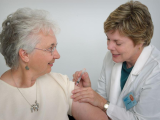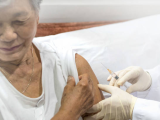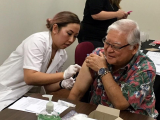Jun 29, 2009 (CIDRAP News) – Novel H1N1 influenza can cause severe respiratory illness, profound lung damage, and death even in patients with no underlying conditions to make them vulnerable, a team of physicians from Mexico report in a rush article published online today by the New England Journal of Medicine (NEJM).
The analysis of 18 patients hospitalized with H1N1 (swine) flu at the National Institute of Respiratory Diseases (INER) in Mexico during the pandemic's earliest days reveals that fewer than half had underlying medical conditions, but more than half needed mechanical ventilation within a day of admission. Seven of the 18 died.
In a companion article, also published in advance online today, a multi-national team from Mexico and the United States document the age distribution of the first month of the H1N1 pandemic in Mexico, where the disease appears to have struck first, and confirm its unusual pattern of severe pneumonia among younger patients. Matching the pattern to those of earlier pandemics, the team speculates on the "biologic plausibility of partial protection" in older people exposed to mid-20th century strains of seasonal flu.
The case series of 18 patients, written by researchers from INER, the Mexican Secretariat of Health and BIRMEX, Mexico's state-owned vaccine-production laboratories, documents the severe illness of the first patients admitted with lab-confirmed H1N1 infection and x-ray–confirmed bilateral pneumonia during the pandemic's first wave.
The 18, of whom 7 died, are a subset of 98 patients hospitalized at the institute with pneumonia or influenza-like illness between March 24, the presumed onset date of the first known case, and April 24. Those 98 were a subset of 214 patients who came to the institute's emergency room with influenza-like illness or severe respiratory distress.
The 18 patients were evenly divided by gender but ranged widely in age, from 9 months to 61 years, with a median age of 38. They were all at least moderately ill, with fever of at least 38°C (100.4°F), cough, and difficulty breathing; 4 of the 5 children had diarrhea.
Most had bloodwork findings that indicated acute viral infections, inflammation and cardiac distress. Half had low blood pressure that persisted after emergency treatment, and 10 of the 18 needed to be put on ventilators within 24 hours of arrival at the hospital.
Eight of the 10—5 of the 11 survivors and 3 of the 7 who died—had a pre-existing medical condition: asthma, sleep apnea, diabetes, or high blood pressure. (In the United States, "The vast majority of the fatalities … do occur in people with underlying conditions," Dr. Anne Schuchat of the Centers for Disease Control and Prevention said in a press briefing Friday. "It's not 100%. It's more on the on order of three-fourths.")
"We did not find a factor that, before the onset of illness, predicted a worse outcome or death among our patients," the researchers said.
In a finding that is likely to fuel an ongoing debate, the researchers found that none of the 18 patients had concomitant bacterial pneumonia, a finding that has been replicated in the United States and that differs from cases recorded during the 1918 pandemic. However, 9 of the survivors and 4 of the deceased received antibiotics during outpatient visits before they reached the institute, and 17 were given antibiotics after admission there, making it unlikely that any bacterial infection would be discovered.
Fourteen of the 18 received the antiviral drug oseltamivir (Tamiflu), either at admission or within a few days of being admitted—in all cases, many days after the 2-day window when flu antivirals are most likely to have an effect.
The patients had a difficult course, with renal failure in 1 survivor and 5 of the deceased and multi-organ failure in all 7 of the dead. Pathological examination of the lungs of one of the dead patients showed severe damage to lung tissue, but, with no bacterial infection evident, the researchers ascribed it to the primary viral pneumonia caused by the new flu. No evidence was found of co-infection with any other virus.
And as evidence of the way the novel H1N1 took Mexico and the world by surprise, the researchers found that the 18 patients passed the flu to their families, with 82 people potentially exposed and 20 ill. Four required hospital treatment, and 1 died. Plus, 22 of the 190 healthcare workers who came in contact with the first 3 patients admitted to the institute also came down with the novel flu, but were sent home with oseltamivir and were only mildly ill.
Like the first set of patients, the healthcare workers and family members who fell ill in the second generation of cases were primarily younger, a situation mirrored in the second paper published today in NEJM. The analysis is by scientists from Arizona State University, the University of California, Berkeley, and the US National Institutes of Health, along with the Mexican Ministry of Health and National Institute of Public Health.
They found that, out of 2,155 reported cases of severe pneumonia and 2,582 lab-confirmed samples of the new flu submitted in Mexico during the pandemic's first month, 71% of severe pneumonias and 87% of deaths occurred in those between the ages of 5 and 59. That pattern is unlike any observed during seasonal flu in Mexico but matches records from the three pandemics of the 20th century, they said.
Perez-Padilla R, de la Rosa-Zamboni D, Ponce de Leon S et al. Pneumonia and respiratory failure from swine-origin influenza A (H1N1) in Mexico. N Engl J Med 2009 (published online Jun 29) [Full text]
Chowell D, Bertozzi S, Arantxa Colchero M et al. Severe respiratory disease concurrent with the circulation of H1N1 influenza. N Engl J Med 2009 (published online Jun 29) [Full text]


















